In the aftermath of 1945, Berlin was left in ruins, bearing witness to the devastating impact of World War II. Even today, the city still bears the scars and bullet holes that serve as poignant reminders of that tumultuous period.
We have been living in Berlin for years now, and these battle scars we see everywhere caught us by surprise during our first months in town. Especially because the battles in and around Berlin happened over seventy years ago, because of these scars and bullet holes, we always watch for the remains of the extraordinary fighting that occurred during April and May of 1945 in Berlin.
And they are everywhere if you know where to look.
In this article, we decided to present some of these places so you can take pictures and record these historical remnants. Some of you may find it a valuable resource and a way to understand the weight of the past that still can be seen all around Berlin today.
Berlin’s Living History: Thirteen Places to Trace WWII Battle Damage in the German Capital

Wounds of Memory at Villa Parey next to Potsdamer Platz
In the mid-19th century, Berlin’s Tiergarten Quarter blossomed from a serene summer retreat on the city’s outskirts into a sought-after residential area for the middle class. Renowned architects like Martin Gropius and Alfred Messel constructed impressive buildings near the bustling Potsdamer Platz, creating a neighborhood of architectural prominence.
Yet, the ravages of war and the dark shadow of the National Socialist regime cast a grim fate upon this once-vibrant quarter. The area was devastated, starting with the Allied force and their air raids in 1943. But, even before World War II, the Nazis confiscated and demolished many buildings, often targeting those owned by Jewish residents, as part of their grand vision for the “north-south axis” of the envisioned “Reichshauptstadt Germania.”
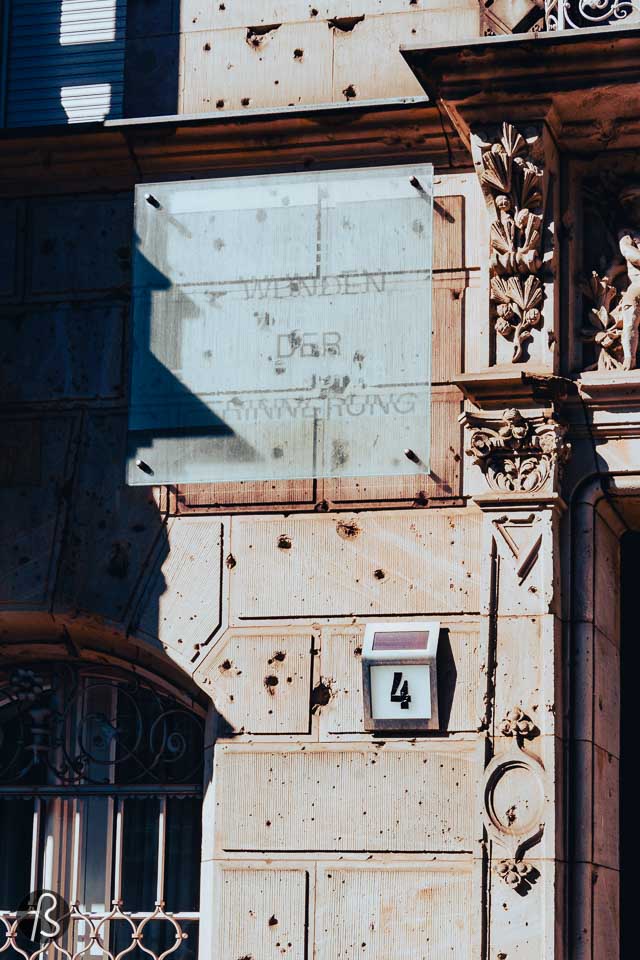

Countless families who called the Tiergarten Quarter home were displaced, deported, or lost their lives under the grip of the National Socialist dictatorship. Today, only faint echoes of the quarter’s illustrious history, grandeur, and vibrant spirit remain in a handful of preserved and reconstructed buildings. One such place is the Villa Parey, integrated into the modern structure housing the Gemäldegalerie.
Within the walls of this historic building, now home to the Photography Collection of the Art Library and the Miniature Collection of the Picture Gallery, fragments of the past were preserved during the restoration after 1990.
The visible bullet holes, remnants of the fierce street battles that raged in April 1945, were deemed “Wounds of Memory.” But, they were saved from being erased following vehement protests.
Today, the Villa Parey stands as a testament to the resilience of the Tiergarten Quarter. Its integration into the new Gemäldegalerie building between 1991 and 1998 signifies the connection between the past and the present, bridging the gap between eras and allowing us to explore the Kunstbibliothek Sammlung Fotografie, a rich collection of photographic art.

The remnants of the fighting at the bridges at Yorckstrasse
When you first look at the Yorckstrasse bridges, they may not appear extraordinary. We passed by bike a few too many times until we realized that there was something out of the ordinary in them. These iconic landmarks in Berlin have withstood the test of time since approximately 1883. Back in 1945, during warfare, these bridges bore witness to significant events that left lasting marks.
As the Soviets advanced from the east of the city, making their way up Yorckstrasse from Gneisenaustrasse and Neukölln, the bridges served as a strategic defensive position for the retreating Germans.
Today, the supporting columns of these bridges display visible remnants of intense fighting. The large damage you observe beneath the surface was likely caused by bombs or artillery fire. The impact has warped the iron, dislodging one of the rivets. At the same time, the opposing wall bears evident signs of battle damage. The weathered, off-white paint job dates back to World War II when the supports were colored in white to remain visible during blackout conditions.

Intense fighting at Saalestrasse in Neukölln
Amid Berlin’s battle-scarred landscape, the unassuming buildings often witness the greatest turmoil. Tucked behind a used car dealership on Saalestraße in Neukölln, an ordinary-looking structure reveals signs of intense fighting.
On April 25th, 1945, Soviet forces advanced from the south, encountering the Nazi-German defense line along the S-Bahn ring, where the railway embankments formed a formidable barrier.
This nondescript building likely served as a sniper or machine gun team hideout, as indicated by a window on the top floor. However, considering the visible damage, their resilience may not have endured for long in the face of relentless combat. Today, we can still see the damage done over seventy years ago.
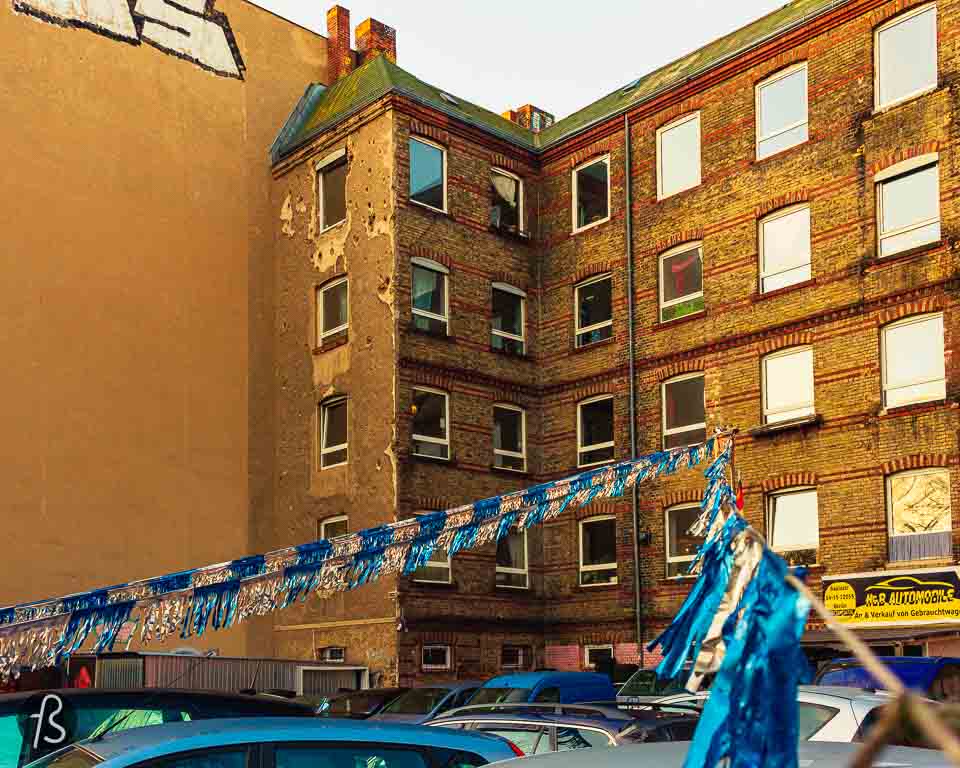
Berlin Battle Damage at Friedhöfe am Halleschen Tor
The cemeteries nestled along Mehringdamm are poignant reminders of Berlin’s rich past. Noteworthy among them is the churchyard of the Trinity Church, where renowned theologian Schleiermacher once preached, and the burial ground of Bethlehem Church, which welcomed Bohemian refugees in the 1730s. Additionally, the old cemeteries of the New Church (corresponding to the German Cathedral on Gendarmenmarkt), the Jerusalem Church (whose original building stood in front of today’s Axel Springer building until the war), and the Moravian Church can be found here.
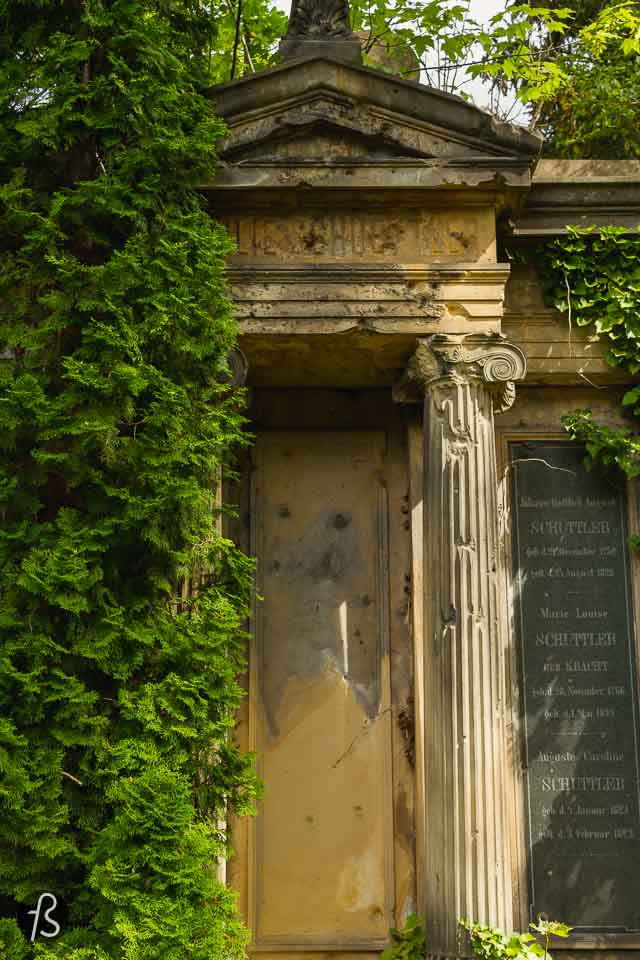
These five cemeteries were established outside the city walls in the 18th century due to the prohibition of burials within the city limits.
Stretching northwards until the 1950s and 1960s, the cemetery once extended to a narrow strip, approximately 32 meters wide, near the present-day Blücherplatz, where the American Memorial Library now stands. The leveling of this area led to the loss of the north wall of Bethlehem Cemetery, which had already suffered damage during the war.
The visible battle scars testify to the relentless advance of the Red Army towards the city center and the Reichstag, where many key targets of Berlin were situated.
Today, these walls and tombstones bear the marks of the Second World War, bearing witness to the trials endured during that tumultuous time. Amidst the remnants, one can also discover the resting places of notable figures such as the composer Felix Mendelssohn-Bartholdy and the writer ETA Hoffmann, whose legacies continue to resonate.
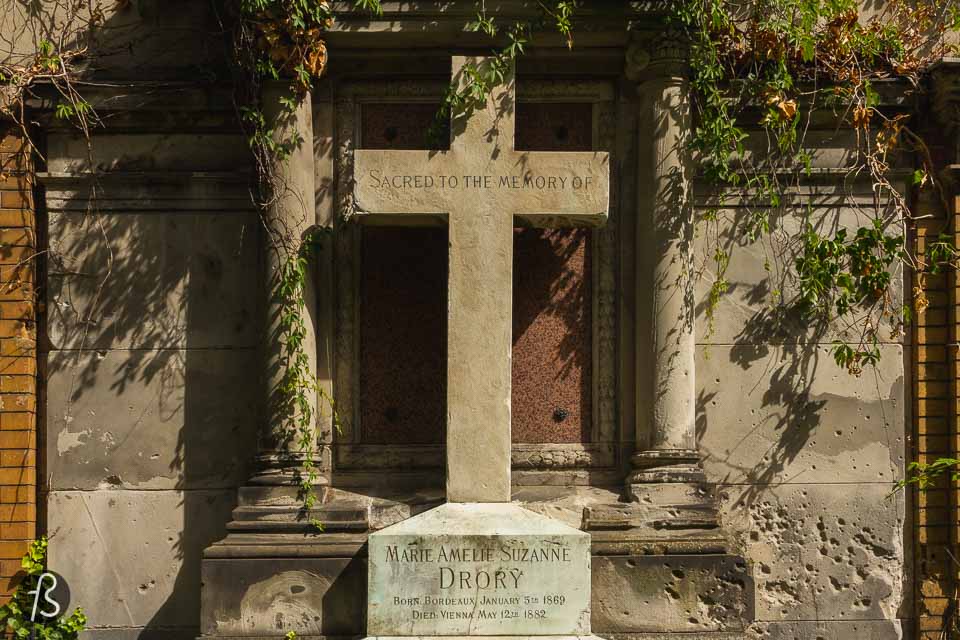
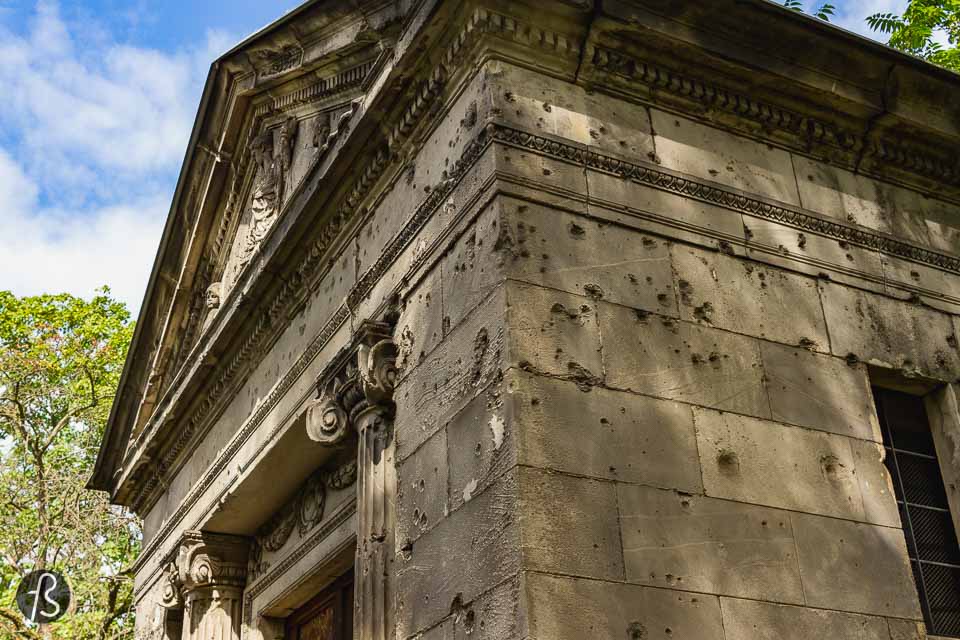
The battle scars adorning the front walls of Sophienkirche in Mitte
The haunting marks left on these church walls make it feel like the fighting occurred mere days ago. On April 24th, 1945, a fierce battle unfolded here as the Soviet 7th Corps clashed with a diverse force comprising elements of the Wehrmacht, SS, Volkssturm, and Hitler Youth units. The intensity of the combat is evident in the ravaged walls, where most damage can be attributed to small-arms fire.
Sophienkirche is a resilient testament to the struggles endured during that fateful day.
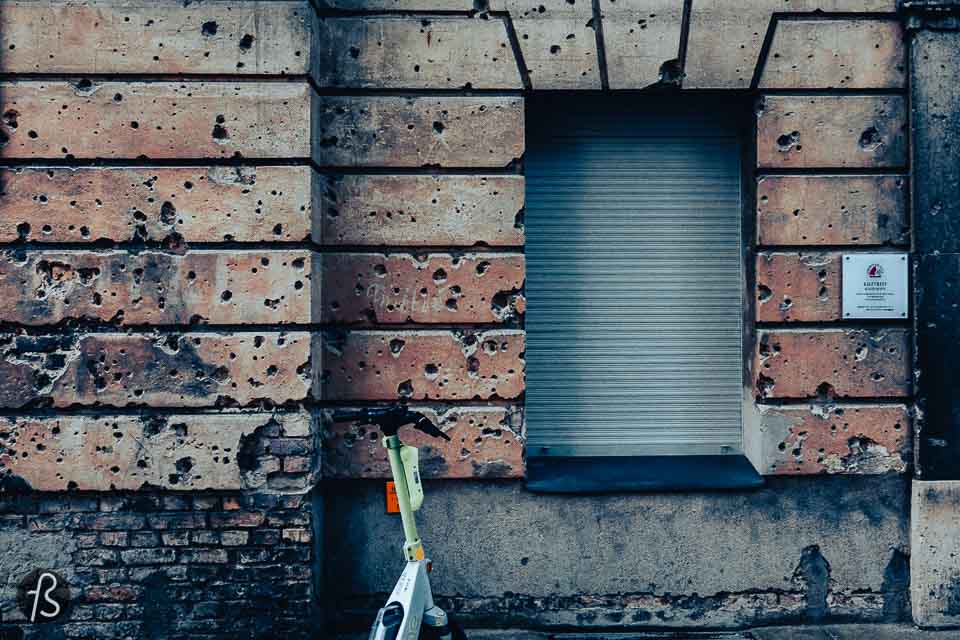
The Splitterschutzzelle around Hermannplatz
Nestled within a parking lot near Hermannplatz lies a small bunker whose historical significance has often eluded documentation. But, its enduring presence is a poignant reminder of Berlin’s wartime past.
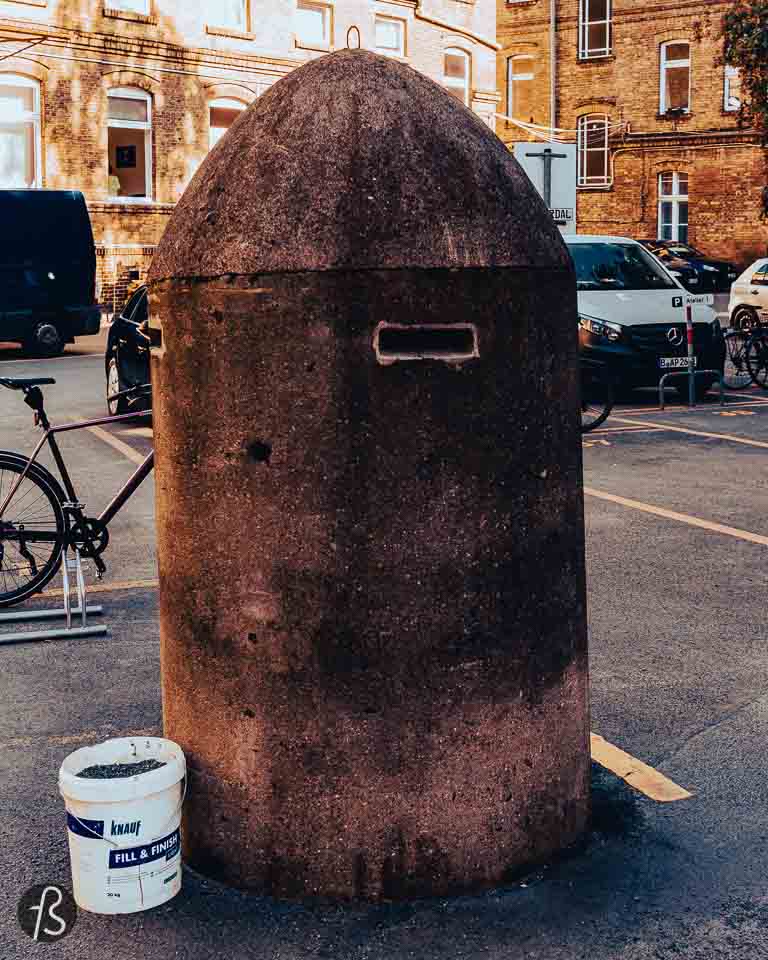
This style of the bunker, known as a Splitterschutzzelle, offers a glimpse into the construction of single-person shelters prevalent during the Second World War. Its cylindrical design, crafted from reinforced concrete, safeguards individuals from flying splinters and debris.
While the existence of bunkers around the U-Bahn Hermannplatz is known, and the involvement of the Karstadt department store in fierce battles during the Battle of Berlin is documented, information about this particular structure still needs to be made available.
Some speculate that this bunker may have a connection to the extensive underground network beneath Karstadt. The possibility of an emergency exit from this small bunker cannot be ruled out. However, conclusive evidence is yet to be uncovered. We invite you to share your knowledge if you have any valuable insights regarding this mysterious structure.

The S-Bahn bridge on Leibnizstrasse in Charlottenburg
One of the supporting columns of the S-Bahn bridge on Leibnizstraße in Charlottenburg bears a remarkable testament to the brutality of the Second World War and the street battles in Berlin. A shell-hole piercing the supporting beam tells a story of devastation. What sets this damage apart is the visible spiraling lines etched by the shell as it passes through.
Our non-professional analysis suggests that this piercing hole resulted from an 85mm armor-piercing shell fired from a Soviet T34 tank.
The trajectory and surrounding damage indicate that the bullet struck the next column after passing through the bridge support, causing a deflection embedded into the nearby brick wall. And you can still see the damage to the walls around the bridge as well.
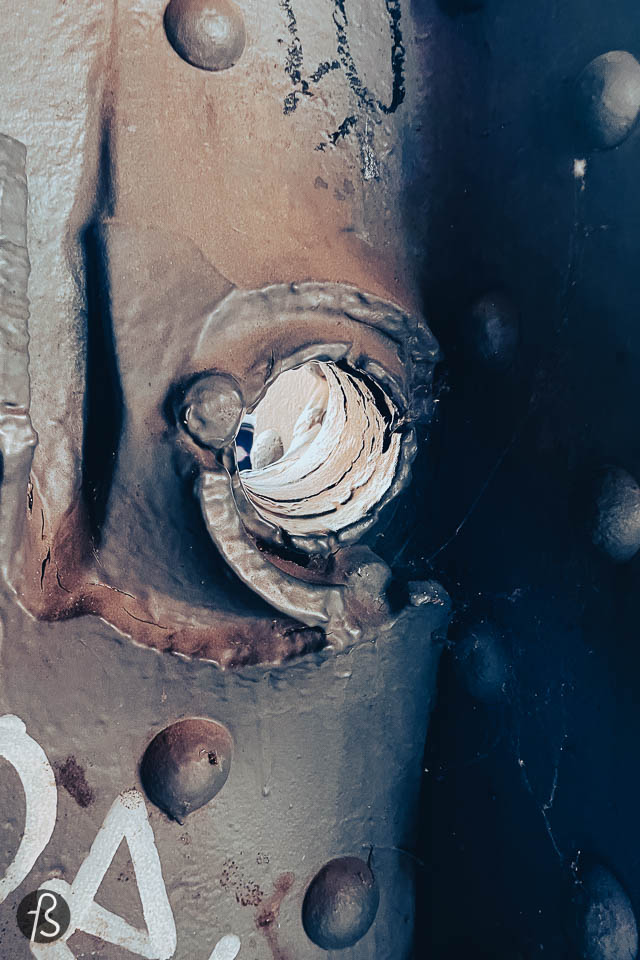
The intensity of the fighting in this location unfolded between April 30th and May 1st, 1945, when the Germans troops made a valiant attempt to break out westwards towards Spandau.
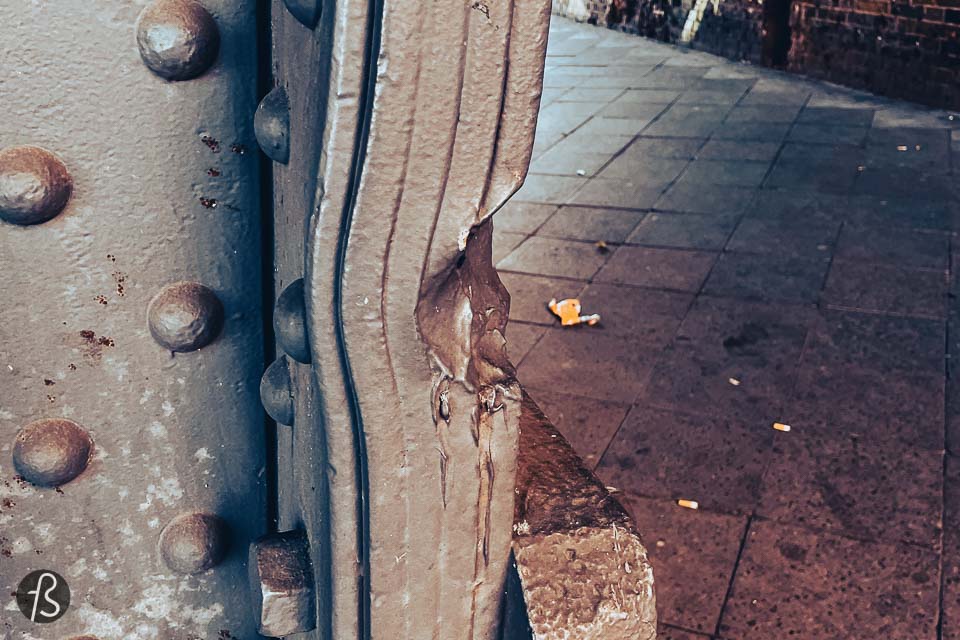
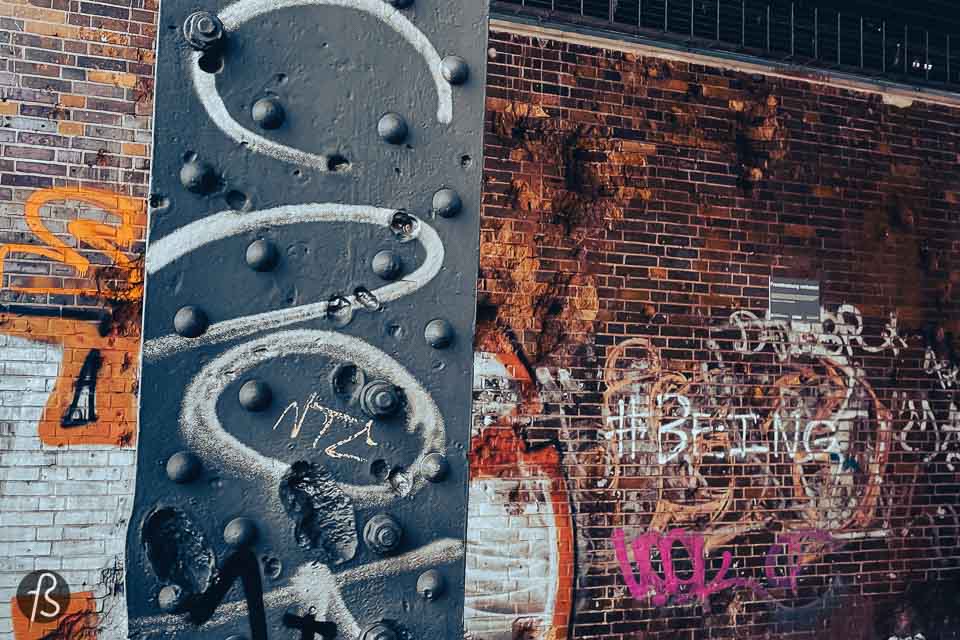
Berlin Battle Damage at Alter Luisenstädtischer Friedhof around Südstern
Located at Südstern in the vibrant Kreuzberg district, the Alter Luisenstädtischer Friedhof is important in Berlin’s history. During the dark era of Nazi rule, this cemetery became the main burial ground for the movement. Between September 1931 and April 1935, 22 Nazis found their final resting place here. Many had met their demise in violent clashes with political opponents.
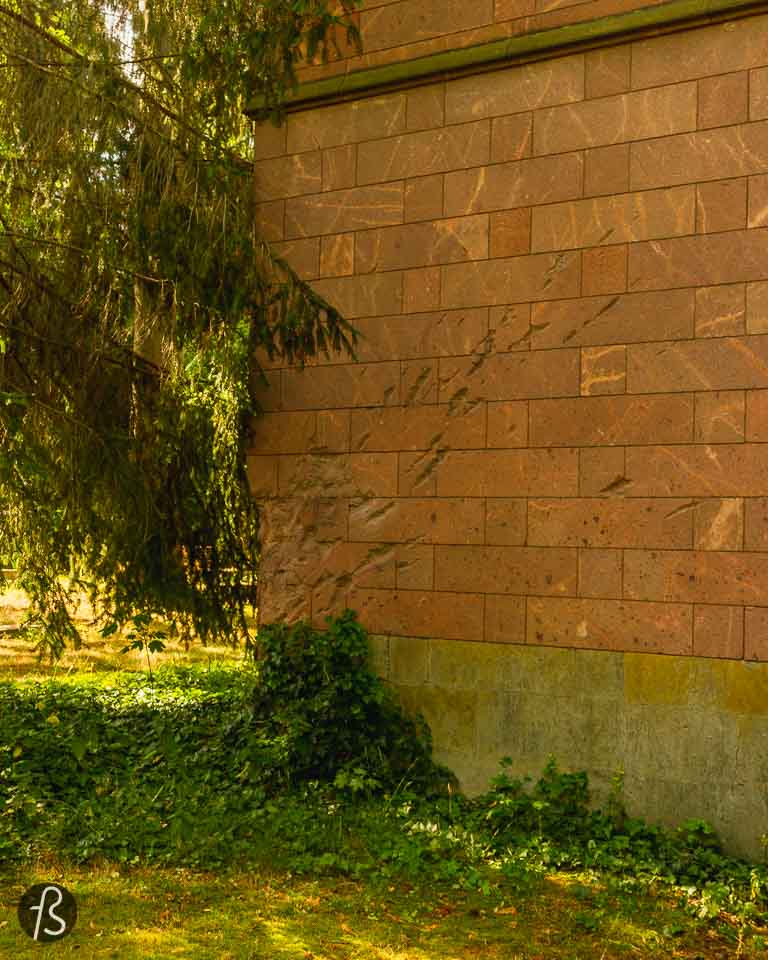
Johannes Wenzel, the pastor of the Neuen Garnisonkirche responsible for this cemetery, openly sympathized with the Nazi party. He played a pivotal role in orchestrating and aligning parts of the Protestant Church with the Nazi dictatorship, leaving an indelible mark on the burial ground’s history.
Today, the graves of those interred during that period can no longer be found. The circumstances surrounding their disappearance remain unclear. However, in their place, the battle scars of World War II tell a different tale.
As the cemetery served as a crossing point from Gneisenaustrasse and Neukölln towards Tempelhof Airport, the visible remnants of conflict bear witness to the intense fighting that engulfed the area.

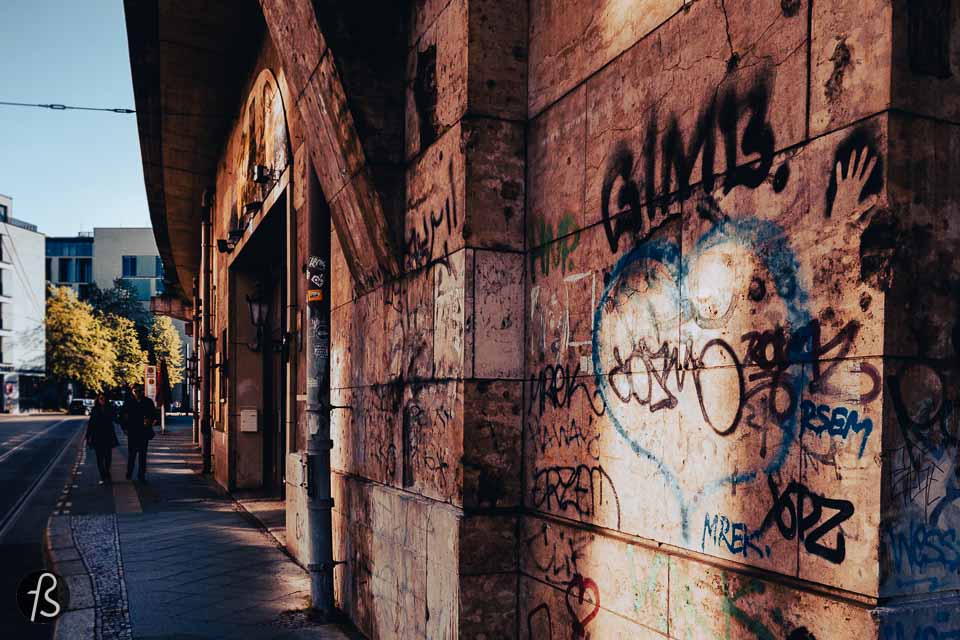
Stadtbahn railway viaduct at Friedrichstrasse
The Stadtbahn railway viaduct, extending east from Friedrichstraße S-Bahn station towards Museum Island, was a significant defensive barrier during the intense fighting of 1945. On April 30th, the Red Army confronted this robust stonework structure, leading to a prolonged standoff. During this time, the SS Nordland Division attempted to break out north along Friedrichstasse on May 1st.
Their efforts proved futile, with only a few units surviving. Today, battle scars stretch along the structure for several blocks. The impact of warfare is clearly visible, a poignant reminder of the fierce clashes in this location and in some of the buildings around it. Like where the Humboldt-Universität zu Berlin School of Business and Economics stands today.
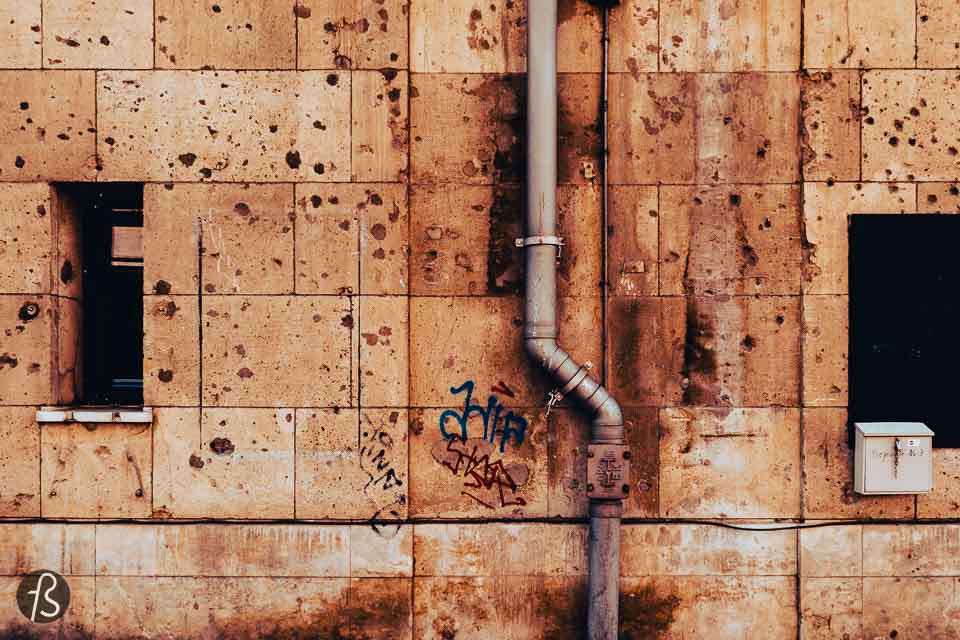
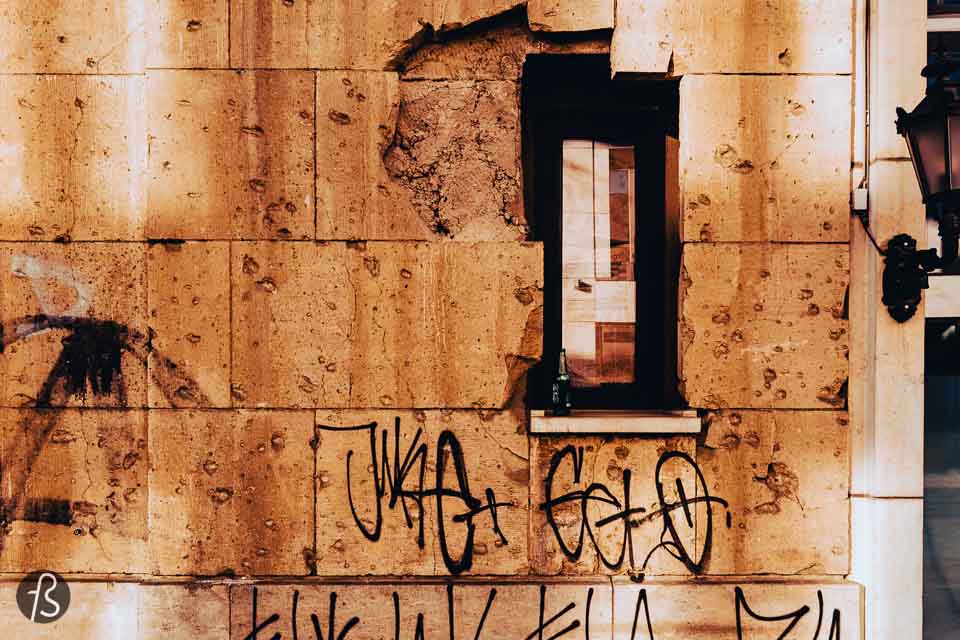
Tank tracks under the bridge at Prellerweg
Amidst the bustling cityscape, hidden sites often escape our notice at first glance. One such area lies beneath the railway bridge on Prellerweg in Tempelhof, where deep gouges mar the cement walls—a poignant reminder of the impact of war.
Passing by this bridge numerous times, we had never contemplated the significance of those deep scratches etched into the concrete. Initially, we attributed them to a car accident or a similar incident. However, our research for this article unveiled the truth behind these enigmatic marks.
These now unmistakable track marks stand tall, surpassing the height of an average bicycle. They offer a glimpse into the scale of the tanks responsible for creating them—a testament to their immense power.
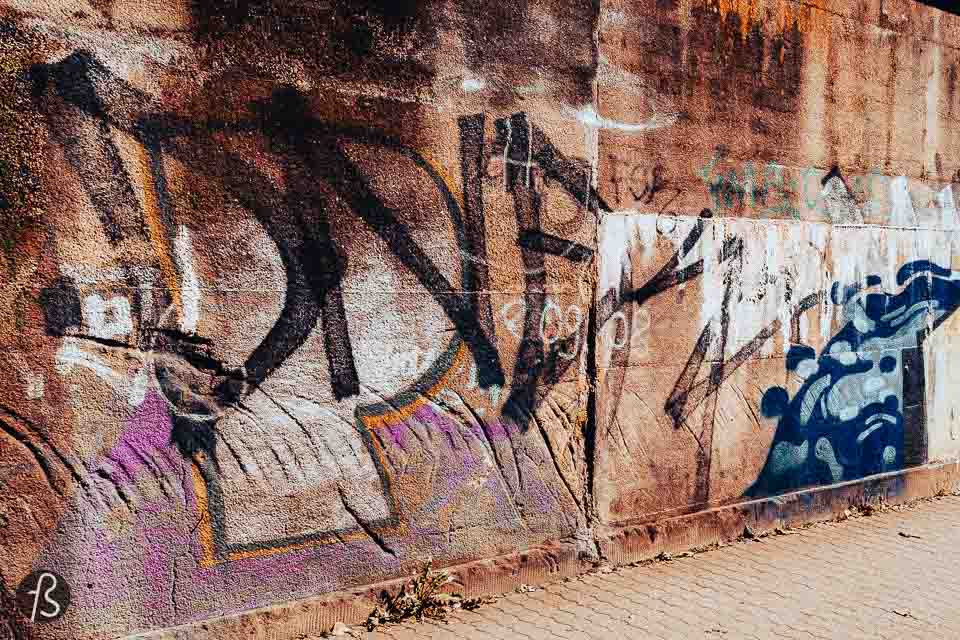
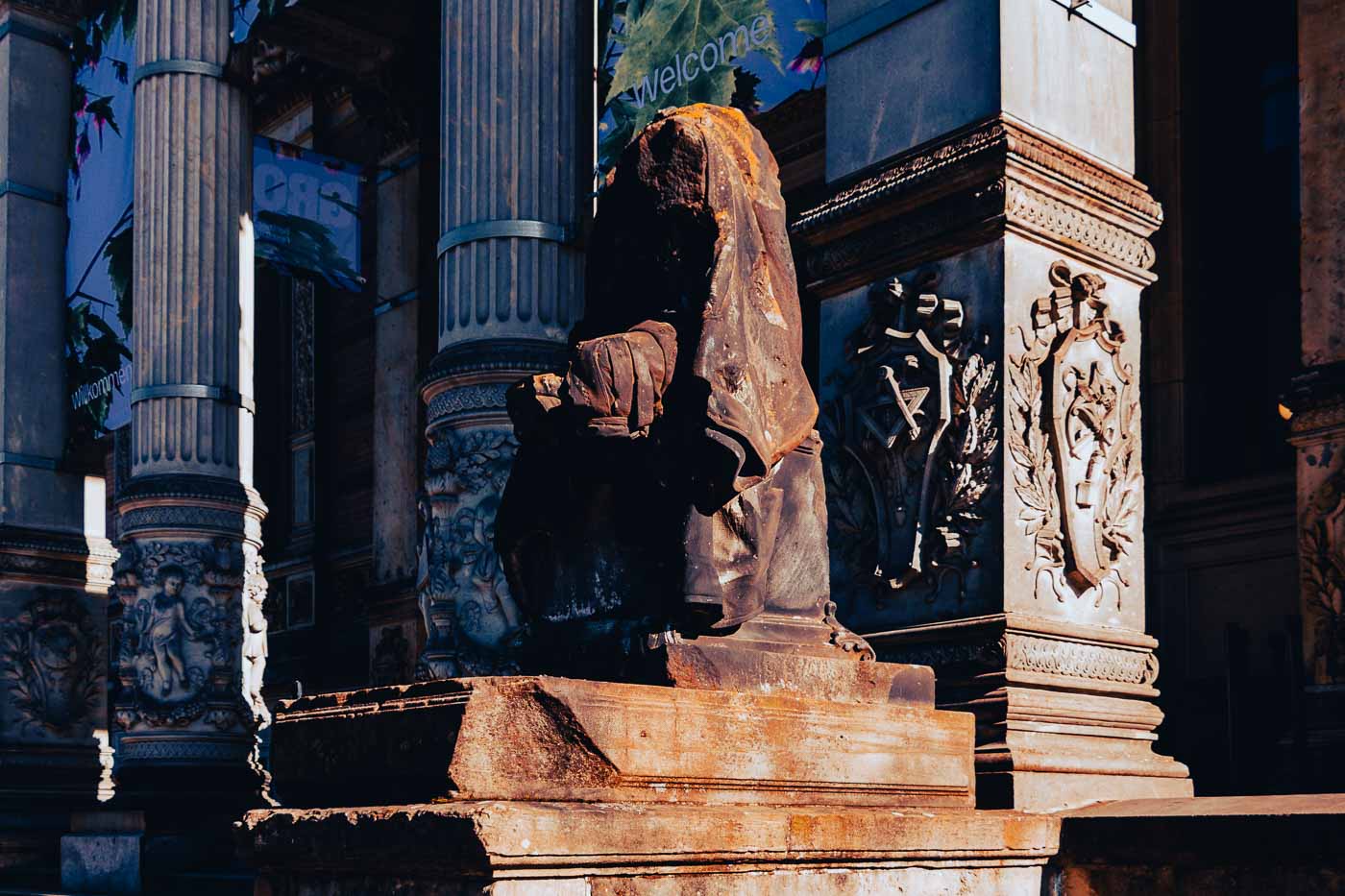
Bullet Holes and Broken Statues around Martin Gropius Bau
In 1945, as it is today, the Martin Gropius Bau was a museum in Berlin. However, the street on which it stands had a different name, Prinz Albrecht Strasse, which held notoriety as the location of the Gestapo headquarters. While the Topography of Terror has replaced the building adjacent to Martin Gropius Bau, it was once a critical target for the advancing Soviet army, determined to dismantle Nazi Germany.
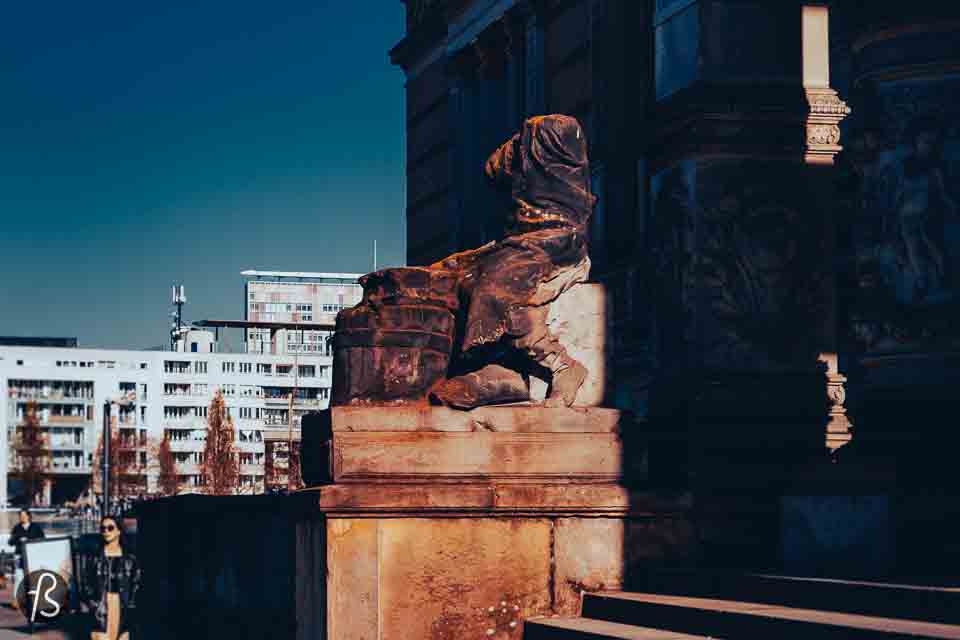
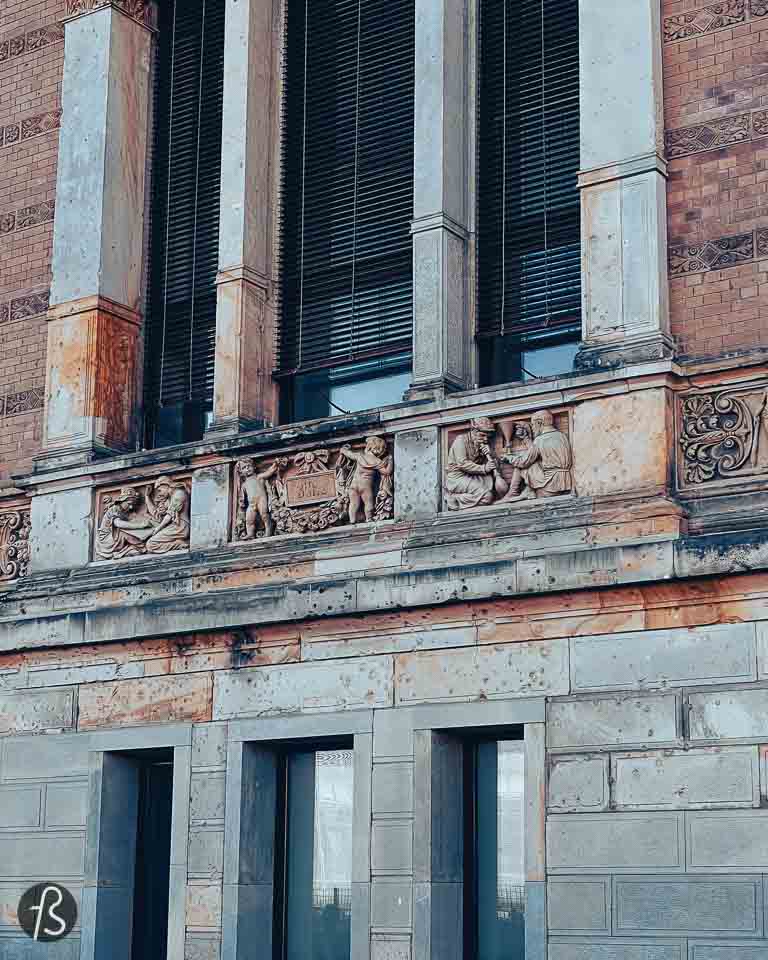
At the break of dawn on April 29th, 1945, the 301st Soviet Rifle Division launched an assault on the Gestapo Headquarters, engaging in heavy combat until they successfully captured the premises.
The remnants of the fierce resistance they encountered from the defending SS forces can still be witnessed on every side of the museum. Still, it’s made clearer by the statues in front of it.

The Flakturm at Humboldthain and its battle damage
Nestled in the Gesundbrunnen area of north Berlin, Volkspark Humboldthain stands as a sprawling landscaped park, originally established in the 1870s to honor the Prussian polymath, geographer, naturalist, explorer, Alexander von Humboldt on his 100th birthday. However, its most fascinating features are the two historic flak towers perched atop a World War II air-raid shelter—a formidable concrete structure from the early 1940s that offers a unique vantage point of northern Berlin.
Commissioned by Adolf Hitler in 1940, the flak towers were constructed in response to the devastating air raids launched by the Royal Air Force on German cities. Because of these air raids initiated a massive construction effort, creating numerous air-raid shelters throughout the German Reich.
The imposing flak towers were towering blockhouse structures armed with powerful anti-aircraft guns. The term “flak” is derived from “Fliegerabwehrkanone,” meaning “aircraft defense cannon” in German. These colossal concrete structures served a dual purpose: defending nearby factories against Allied aerial attacks and providing refuge for tens of thousands of civilians during air raids. At the same time, scores of forced laborers toiled day and night to complete the formidable structures. Owing to the strategic importance of the Humboldthain area and the factories it sheltered, it became a prime target for British and American bombers, losing many forced laborers during the raids.
Most of these defensive structures were dismantled and demolished after the war. However, the two northern towers at Volkspark Humboldthain were spared due to the potential risks associated with their demolition. The nearby railway tracks fell under Soviet administration, and any damage inflicted upon them could have triggered a diplomatic incident.
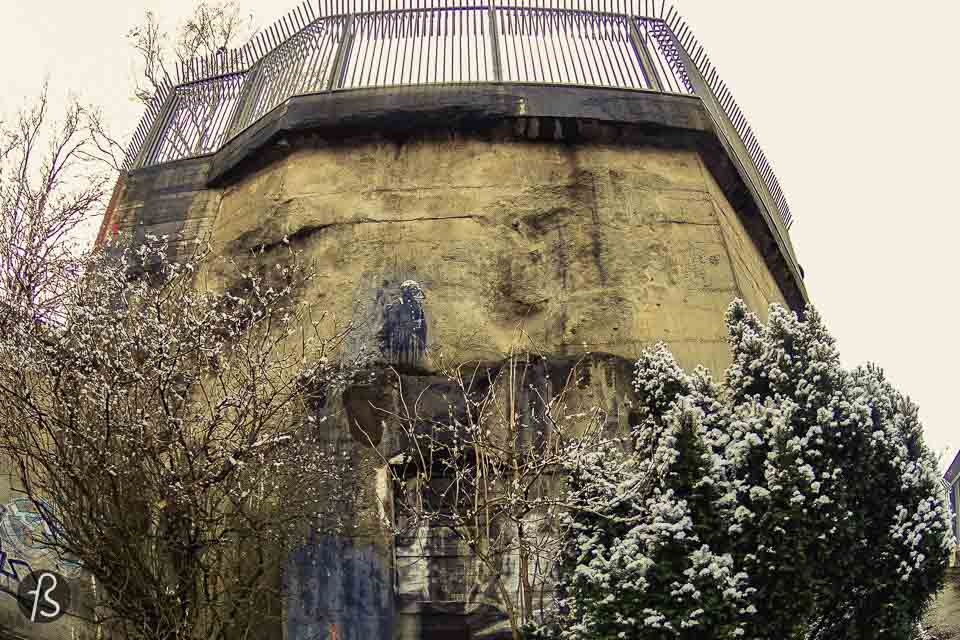
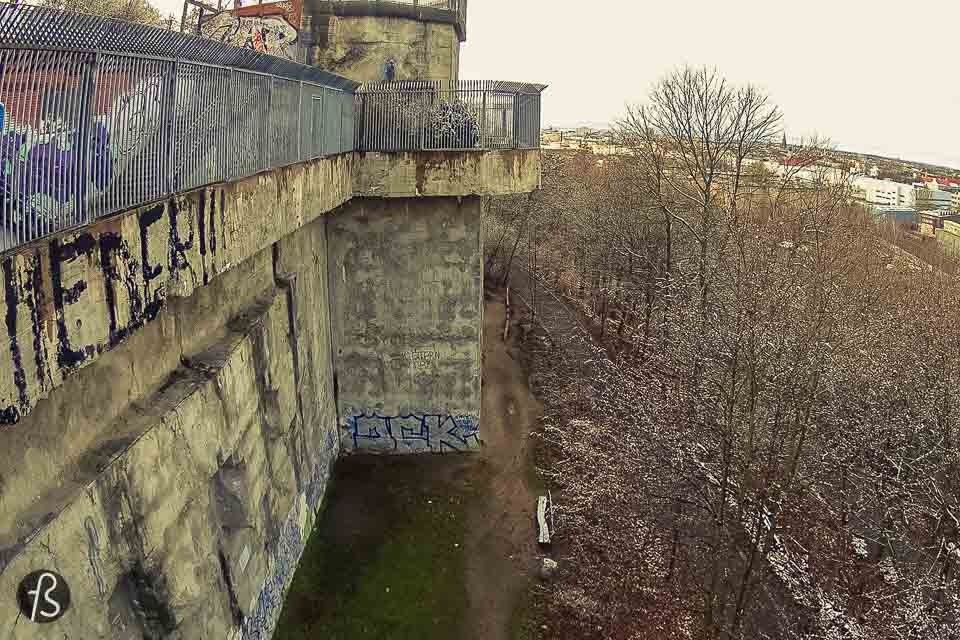
Subsequently, in the years after the Second World War, Allied forces transported 1.4 million cubic meters of wartime debris to Volkspark Humboldthain, forming two hills of rubble that largely concealed the remaining concrete structures. This practice was common throughout Berlin during the post-war reconstruction period, with several similar rubble hills created, such as Teufelsberg in Grunewald.
Today, the scarred walls of the flak towers serve as a playground for rock climbers, who skillfully navigate the pockmarked surfaces, finding their footing amidst the remnants of a tumultuous era. And you can also visit it with the people from Berliner Unterwelten as we did many times.
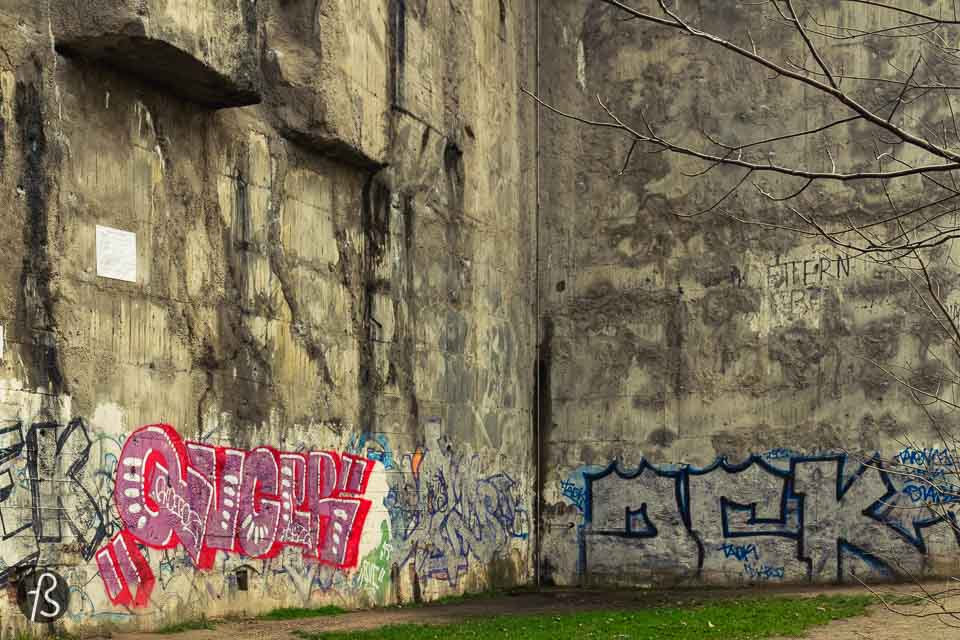
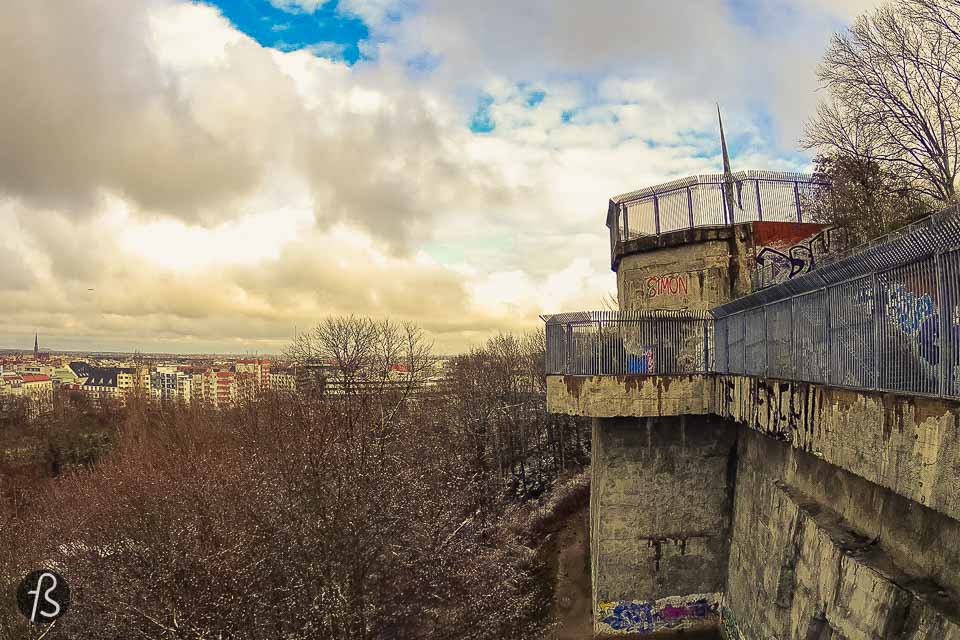
What remained from Pre-War Alexanderplatz
The devastating impact of the Second World War and later post-war developments left most buildings east of Alexanderplatz in ruins or razed to make way for the construction of massive edifices required to accommodate the population of East Berlin. Amidst the transformation, a remarkable survivor stands across from the Alexa shopping center, catching the attention of those who take notice of the vacant plot at the intersection of Alexanderstrasse and Magazinstrasse. However, few realize that the neighboring building, once the 1940s Postamt 27, is also missing a significant portion.
Another one of these buildings is located at Ifflandstrasse 11. This structure, believed to be a former teacher’s residence for the 19th Volksschule, managed to withstand the ravages of war, bearing visible scars from its wartime ordeal.

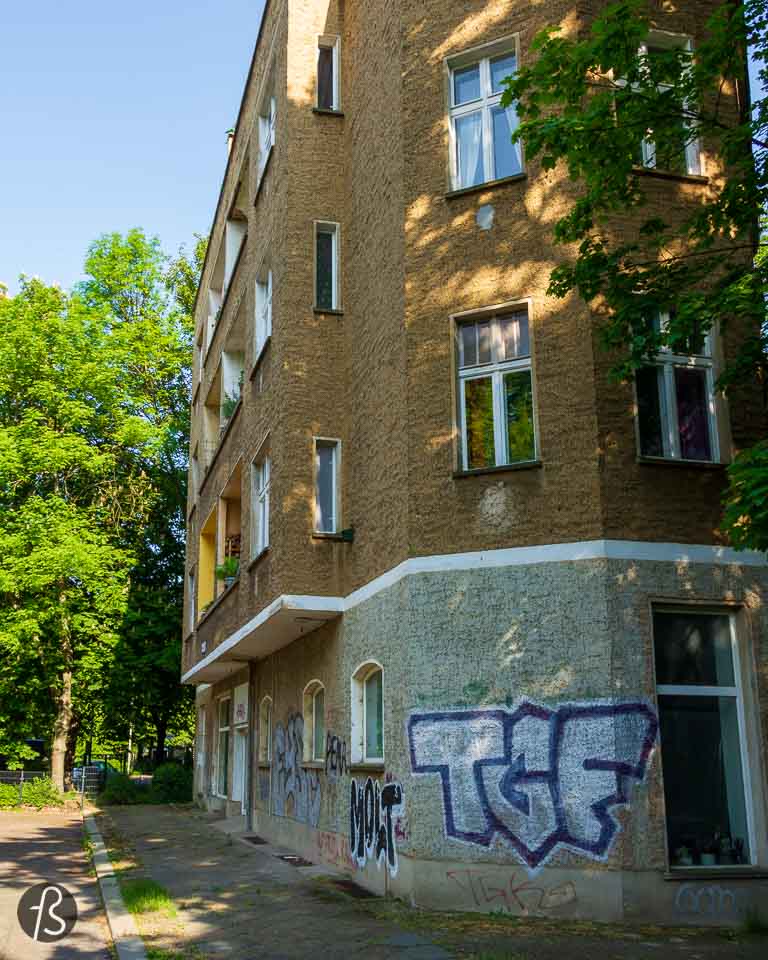
Another testament to the reshaping of Berlin’s cityscape can be found at Singerstr. 1 (formerly Blumenstrasse. 11, Berlin-Mitte). This residential building exemplifies the profound alterations to the urban fabric that occurred in the heart of Berlin after the Second World War. Examining the historical images, one can observe the presence of a bustling street corner that has now vanished, leaving behind a fragment in time—a corner leading nowhere.
These surviving buildings are poignant reminders of the city’s not-so-distant past, where the landscape was vastly different. Some still bear battle marks, while others have concealed their wounds. However, upon closer inspection, the scars remain as reminders of the tumultuous past that forever shaped Berlin’s identity.

In the aftermath of 1945, Berlin was left in ruins, bearing witness to the devastating impact of World War II. Even today, the city still bears the scars and bullet holes that serve as poignant reminders of that tumultuous period. But these scars and bullet holes have a way of capturing our attention and igniting our curiosity.
As we explore the city, we realize that these reminders of the past are everywhere, etched into the fabric of Berlin’s landscape. Each scar tells a story of the fierce fighting during the war’s closing stages, from crumbling facades to pockmarked walls.
These battle scars hold a profound significance not just for history enthusiasts and war historians but for everyone who walks the streets of Berlin. They serve as tangible connections to the past, linking us to the struggles and sacrifices of those who came before us. They remind us of the importance of preserving the memory of the past and learning from it to shape a better future.
With its battle scars displayed, Berlin stands as a living history museum. It teaches us the importance of resilience, unity, and the enduring spirit of a city that has risen from the ashes. The scars may be reminders of a painful chapter. Still, they also symbolize the triumph of hope and the indomitable human spirit.
Let us honor the past and ensure that these scars are a constant reminder of the price paid for peace and the unwavering resolve to never let history repeat itself. Berlin’s battle scars are a testament to the enduring legacy of a city that has transformed its wounds into powerful symbols of remembrance and resilience.